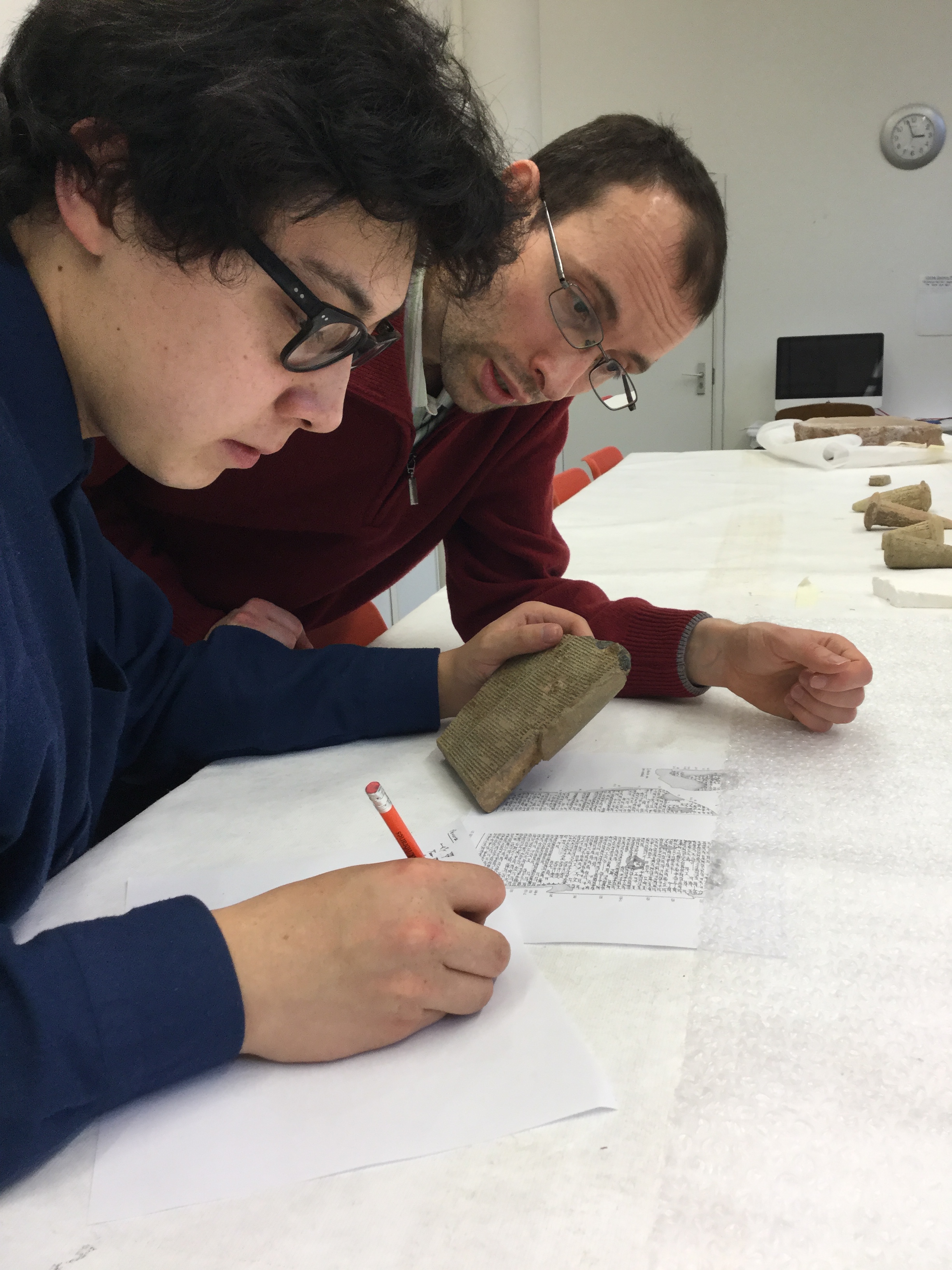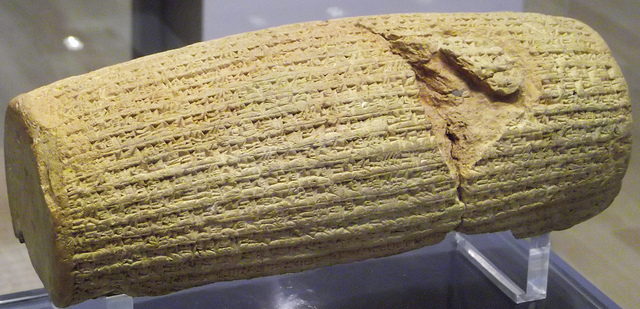
The principal languages of ancient Mesopotamia were Sumerian, Babylonian and Assyrian (together sometimes known as 'Akkadian'), Amorite, and - later - Aramaic. They have come down to us in the "cuneiform" (i.e. wedge-shaped) script, deciphered by Henry Rawlinson and other scholars in the 1850s. The subject which studies Mesopotamian languages and the sources written in them is called Assyriology.
Mesopotamian languages in the cuneiform script are mostly written on clay tablets, though they could also be carved on stone (example here). Being incredibly durable, clay tablets have been recovered in thousands at archaeological sites from the Mediterranean to Bahrain to Iran. More are found by the year.
As well as records of daily life and administration, they include religious, mathematical, musical and astronomical texts, the earliest known laws, and a rich literature that includes the Epic of Gilgamesh and the oldest versions of the Flood Story also known from the Bible.
As the world's first fully urban society, ancient Mesopotamia is of paramount interest to world archaeology, and its art, architecture and technology were the rival, and indeed often the precursors, of Egypt's. Mesopotamia was open on all sides to its neighbours, and its influence can be traced from India to Greece: the Pharaoh's scribes used cuneiform script to correspond with the Great Kings of the Hittites in Turkey, at Ugarit on the Syrian coast the forerunners of the Phoenicians kept their legal and commercial records on cuneiform tablets in Babylonian, and later the Biblical and Classical worlds grew up in the shadow of these ancient cultures to the east (and sometimes under their direct political domination).
The Cuneiform script
... is so called because each individual stroke (several of which might be used to form a sign) has the shape of a wedge. This is the shape which occurs naturally when one impresses a stylus (writing implement) with a triangular cross-section into a flat surface of clay.
The script was invented before 3000 BC. It started out as pictures (a bit like Egyptian hieroglyphs), but these quickly became so stylised as to be unrecognisable. Thus cuneiform signs were born. When they are first used there is so little  grammar it is impossible to tell which language is being written. The first language they do write is Sumerian.
grammar it is impossible to tell which language is being written. The first language they do write is Sumerian.
With possible exceptions in the late first millennium BC, the cuneiform script only writes syllables (a, ba, al, bal). It thus cannot be used to write individual consonants.
To try converting modern text into cuneiform, click the link to the transliteration tool or follow the instructions at the bottom of this page.
Sumerian
Sumerian is an "agglutinating" language with no known relatives. It was spoken in South Iraq until it died out, probably around 2000 BC, giving way to Babylonianian; but it survived as a scholarly and liturgical language, much like mediaeval Latin, until the very end of cuneiform in the late 1st millennium BC.
In the absence of related languages, Sumerian has had to be learned through the filter of Babylonian and Assyrian. There are still many disagreements about what words mean, and how the verb behaves, but our knowledge of it is growing by the year. There is still no full dictionary of Sumerian, though the Sumerian-French lexicon recently posted online by the Swiss scholar Pascal Attinger is very useful.
There is no learner's grammar of Sumerian that can straightforwardly be recommended. Non-specialists may find the excellent grammar of third-millennium BC Sumerian by the Dutch scholar Bram Jagersma heavy-going. The open-access publication Introduction to the Grammar of Sumerian by Gábor Zólyomi is more accessible.
(Akkadian) Babylonian and Assyrian
Assyrian and Babylonian are members of the Semitic language family, like Arabic and Hebrew. Because Babylonian and Assyrian are so similar – at least in writing – they are often regarded as varieties of a single language, today known as Akkadian. How far they were mutually intelligible in ancient times is uncertain.
During the 2nd millennium BC, Babylonian was adopted all over the Near East as the language of scholarship, administration, commerce and diplomacy. Later in the 1st millennium BC it was gradually replaced by Aramaic, which is still spoken in some parts of the Middle East today.
Babylonian was deciphered in the mid nineteenth century. As there was controversy over whether the decipherment had been achieved or not, in 1857 the Royal Asiatic Society sent drawings of the same inscription to four different scholars, who were to translate without consulting one another. A committee (including no less than the Dean of St Paul's Cathedral) was set up to compare the translations. The committee's report, available here, is still fascinating reading after over 150 years.

Further online resources
You can listen to modern scholars reading Babylonian and Assyrian poetry here, a website set up by Dr Martin Worthington when he was a British Academy Postdoctoral Research Fellow at SOAS.
An excellent survey article on Babylonian and Assyrian by Andrew George (SOAS, University of London) is available here.
Several websites give original texts and English translations: Sources of Early Akkadian Literature, the Electronic Text Corpus of Sumerian Literature (not always reliable on a word-by-word basis, but excellent for an overview),
the Open Richly Annotated Cuneiform Corpus.
Books
Irving Finkel and Jonathan Taylor, Cuneiform, London: The British Museum
Dominique Charpin, Reading and Writing in Babylon, Cambridge MA: Harvard University Press
John Huehnergard, A Grammar of Akkadian (3rd ed.), Winona Lake IN: Eisenbrauns
Martin Worthington: Teach Yourself Complete Babylonian (2nd ed.), London: John Murray. The first edition is accessible here.
Associations
... for those interested in Mesopotamian languages include:
The International Association for Assyriology
The British Institute for the Study of Iraq
The London Centre for the Ancient Near East
Mesopotamian Languages at Cambridge
Undergraduates in the Department of Archaeology can study Babylonian in all three years, and Sumerian and Assyrian in their third year. MPhil students can study Babylonian at introductory or advanced level, and also Sumerian (normally only if they already have some Babylonian). After the introductory level it may also be possible to study Assyrian.
Babylonian set texts in previous years have included extracts from: the Cyrus Cylinder (pictured above), the Flood Story in the Epic of Gilgamesh, Sennacherib's inscriptions describing the siege of Jerusalem, and the law code of Hammurapi.
You can see listings of set texts from previous years' courses here, as a guide to the sort of things you might read yourself.
A website for converting "transliteration" (i.e. Babylonian or Sumerian written in Roman characters) into Cuneiform signs is available here.
Try entering ha-am-mu-ra-pí to see the name Hammurabi written in cuneiform.
Using most browsers, the cuneiform should appear on your screen, as the fonts are embedded in the website. However, if you wish to copy-and-paste (e.g. into a Word document), you may need to install the fonts in order for the characters to display correctly. To install the fonts, follow the links below:
Santakku — http://www.hethport.uni-wuerzburg.de/cuneifont/ (click on “Old Babylonian Fonts”)
CuneiformOB — http://oracc.museum.upenn.edu/doc/help/visitingoracc/fonts/index.html
SantakkuM — http://www.hethport.uni-wuerzburg.de/cuneifont/ (click on “Old Babylonian Fonts”)
UllikummiA — http://www.hethport.uni-wuerzburg.de/cuneifont/ (click on “Hittite Fonts”)
UllikummiB — http://www.hethport.uni-wuerzburg.de/cuneifont/ (click on “Hittite Fonts”)
UllikummiC — http://www.hethport.uni-wuerzburg.de/cuneifont/ (click on “Hittite Fonts”)
Assurbanipal — http://www.hethport.uni-wuerzburg.de/cuneifont/ (click on “Neo-Assyrian Font”)
CuneformNA — http://oracc.museum.upenn.edu/doc/help/visitingoracc/fonts/index.html


